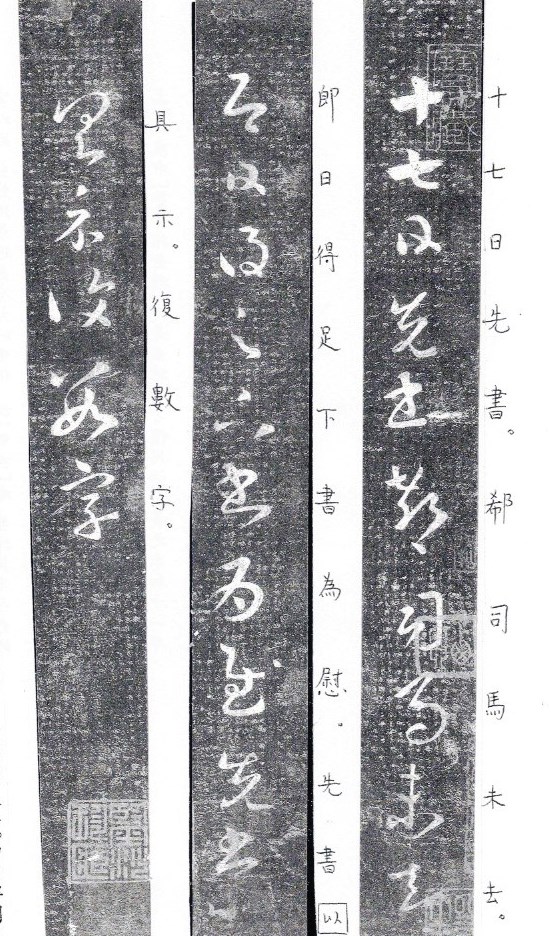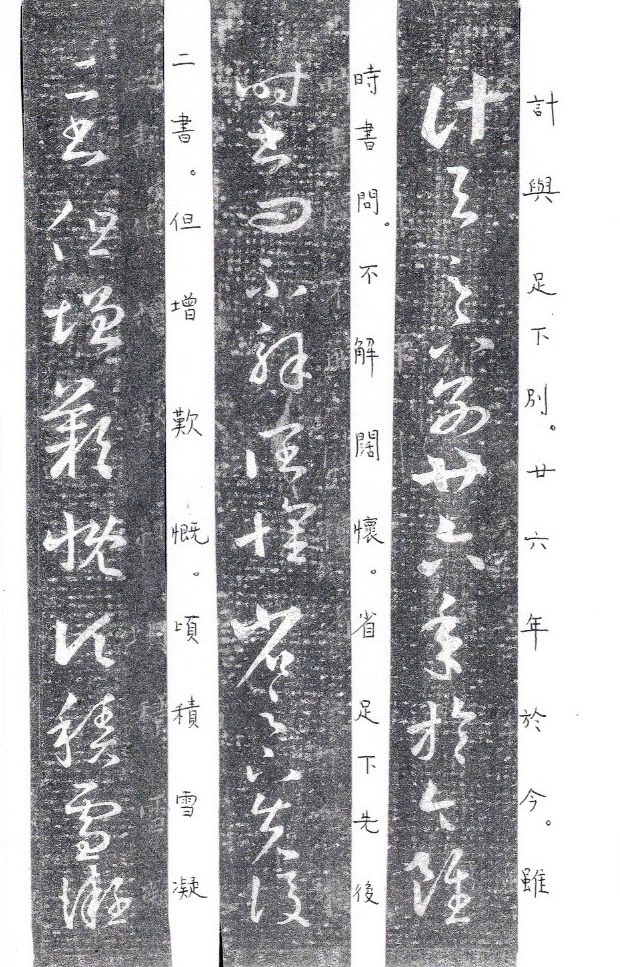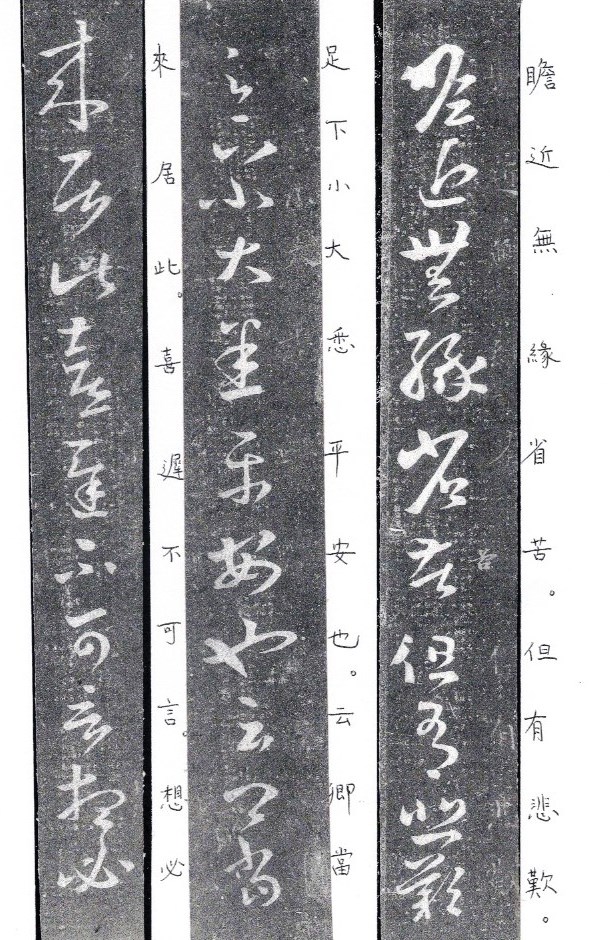Shi Qi Tie (十七帖) also known as ‘The Seventeenth’ is a famous masterpiece of Wang Xizhi’s cursive script writing (王羲之草書). It is a collection of 29 letters to his friends. The original ink writings have long been lost and the Shi Qi Tie handed down now is an engraved version.
Tang Taizong (唐太宗)(598 – 694) was an passionate collector of Wang Xizhi calligraphy during his reign, and went to extreme lengths to collect all the known extant Wang Xizhi works. He commissioned professional calligraphers to do careful reproductions of the works in the imperial collection and patronized Wang-style calligraphers at his court, many of whom held high-ranking posts.
Wang Xizhi wrote these letters to his friends from the third year of Yonghe (永和三年)(347 CE ) to the fifth year of Shengping (升平五年)(361 CE) over 14 years. Many of them are believed to be written to Zhou Fu (周撫), the chief of Yizhou prefecture (益州刺史) in Shu (蜀)(nowadays Sichuan 四川).
Shi Qi (十七) are the first two characters of the first letter. The whole collection was named Shi Qi Tie (十七帖). The sequence of arrangement the 29 letters is very special. It begins with letters of calm and clear writings to letters of vivid and unrestrained writings at the end. The calligraphy is elegant but retains a beauty derived from conciseness and archaic simplicity. Shi Qi Tie has always be regarded as a model work of cursive script.
The letters are short and brief, similar to the SMS messages nowadays. The meanings of some sentences in the letters are difficult to comprehend without knowing the context or background. Many scholars and calligraphers throughout the past centuries have been studying Shi Qi Tie extensively.
Shi Qi Tie has a few versions. The version I used is Uenomoto version (上野本) kept in Kyoto National Museum (京都国立博物館). Letter 11 comes from Mitsui (三井) version. The images of ink rubbings have been photographical modified, with black and white reversed so that the characters are black on a white background.
1 Si Sima Tie (郗司馬帖)

1 Si Sima Tie (郄司馬帖)
十七日先書,郗司馬未去,即日得足下書為慰。先書以(已)具示,復數字。
The first few sentences can be interpreted in more than one way.
i 十七日這天,信已寫好了,本來想郗司馬(郗曇)帶去,還未啟程當天就得到您(周撫)的來信,甚感安慰。On the 17th day, the letter was written and I asked Xi Sima (郗司馬, Xi Tan郗曇) to take it to you (Zhou Fu 周撫) but he still has not yet set off. I received a letter from you which is very comforting.
ii 十七日已先有書信送來,郄司馬(郗曇)當時還未離開。當日得到您的回信,甚感欣慰。On the 17th day, the letter arrived. Xi Sima has not yet departed. I was so thankful to receive your letter.
先書以(已)具示,復數字。All I want to say has been written in my previous letter and here I simply reply with a few words.
(Xi Tan郗曇 is the brother of Wang Xizhi’s wife.)
2 Yi Men Tie (逸民帖)
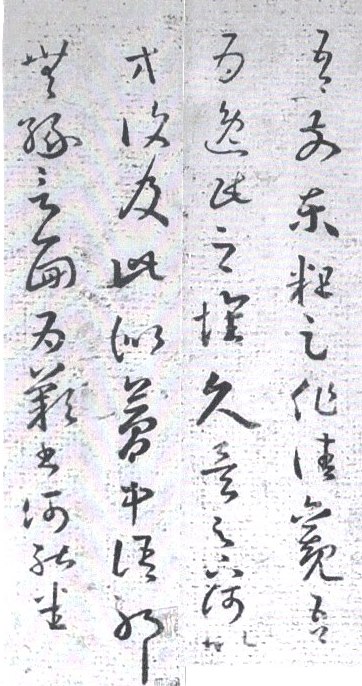

吾前東,粗足作佳觀。吾為逸民之懷久矣,足下何以方復及此,似夢中語耶!無緣言面為歎,書何能悉?
The last time I travelled east, I saw the beautiful scenery of mountains and rivers. I have been thinking of retirement and living in seclusion. Why do you bring it up again now, like something in a dream! We cannot meet face to face and talk about that now. What a pity! It is not easy to express myself clearly by writing.
3 Long Bao Tie (龍保帖)
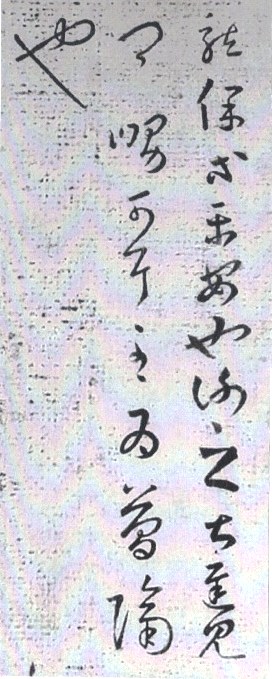

龍保等平安也,謝之。甚遲見卿舅可耳,至為簡隔也。
Long Bao (龍保) and others are all well. Thank you. I am longing to meet your uncle. Is he all right? We are certainly separated by a far distance.
4 Si Buyi Tie (絲布衣帖)


今往絲布單衣財(才)一端,示致意!
I hereby send you a single coat made of silk cloth. This is not much, but it expresses my thoughts.
The character 端 can also be interpreted as a measure of length. A certain length of silk cloth could be used to make the coat.
5 Jixue Ning Han Tie (積雪凝寒帖)
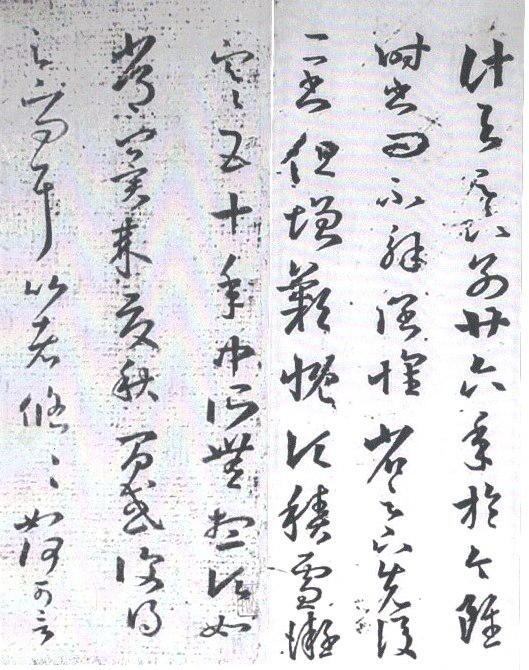
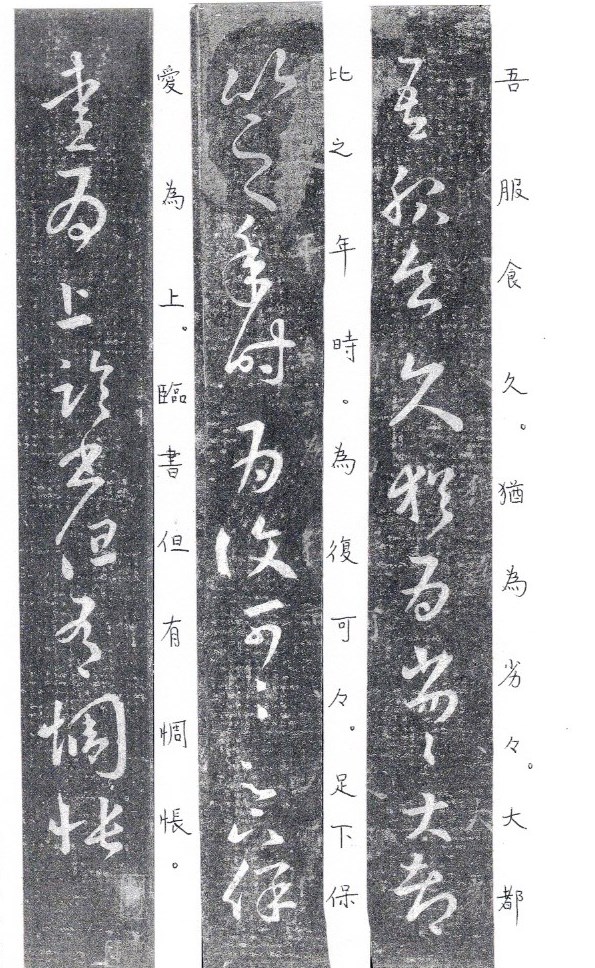
計與足下別,廿六年於今,雖時書問,不解闊懷。省足下先後二書,但增歎慨。頃積雪凝寒,五十年中所無。想頃如常,冀來夏秋間,或復得足下問耳!比者悠悠,如何可言?
Counting the years, it has been twenty six years since we (Zhou Fu 周撫) last saw each other. Despite we write to each other, it is difficult to relieve our sentimental thoughts. Your last two letters added more sighs and emotions to my heart. The snow has fallen heavily and the weather is freezing cold, a phenomenon not seen in the last fifty years. I hope you keep well and I look forward to receiving a letter from you next summer or autumn.
(The last sentence 比者悠悠,如何可言 can be interpreted in more than one way.)
i 方今歲月谩長,要從那裏説起。The year lingers on and I do not know where to start saying.
ii 近來思緒悠悠,豈是言語所能表達。Recently I have lots of thoughts and I do not how to express myself.
iii 我最近無所事事,真不知道怎樣説才好。Recently I am idling and I do not know what to say.
6 Fu Shi Tie (服食帖)
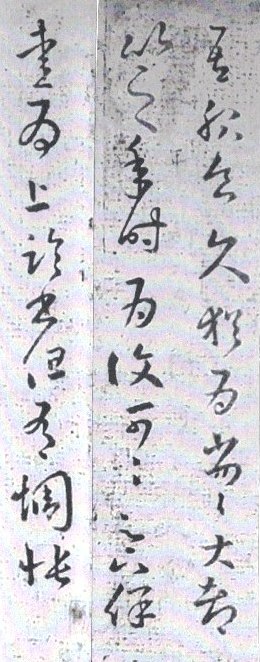

吾服食久,猶為劣劣。大都比之年時,為復可可。足下保愛為上,臨書但有惆悵。
Despite I have been taking the drug for a long time, my health is not good. Compared with previous years, my health is a bit better. It is important for you (Xi Min 郗愔) to take good care of yourself. When I write this letter, I feel infinitely sad and melancholy.
(Xi Min 郗愔 is the brother of Wang Xizhi’s wife.)
7 Zhi Zu Xia Tie (知足下帖)
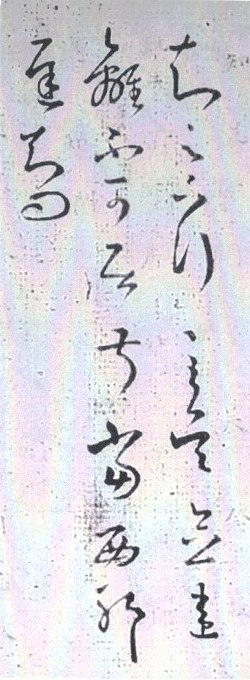
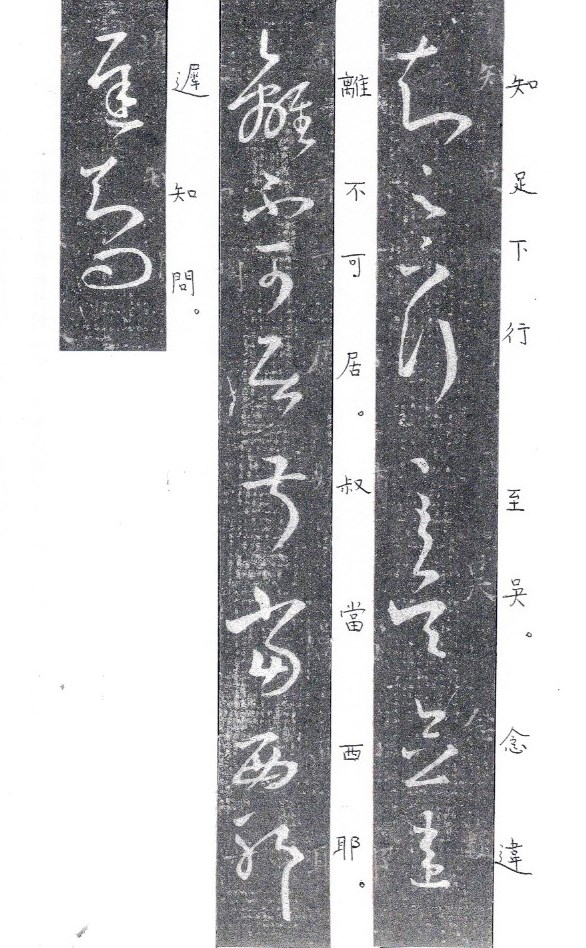
知足下行至吳,念違離不可居。叔當西耶?遲知問。
I know that you (Xi Min 郗愔) arrived at the province of Wu (吳), yet I think it is too far away from your home and so it is undesirable for you to reside in. Does Xi Tan (郗曇) have any plans to travel west? Hope you can reply.
(Both Xi Min 郗愔 and Xi Tan (郗曇) were the brothers of Wang Xizhi’s wife. Xi Min was older than Xi Tan.)
8 Zhan Jin Tie (瞻近帖)
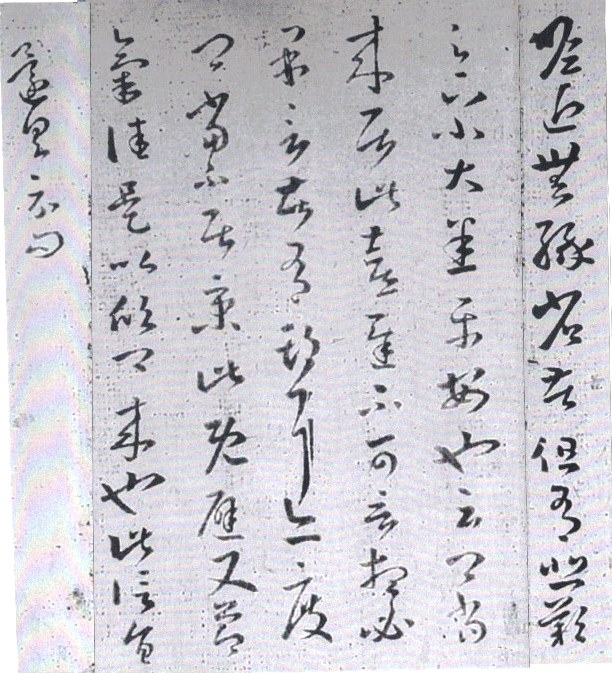

瞻近無緣省苦(告),但有悲歎!足下小大悉平安也。云卿當來居此,喜遲不可言!想必果言,苦(告)有期耳。亦度卿當不居京,此既避(僻),又節氣佳,是以欣卿來也。此信旨還,具示問!
It seems that there is no chance for us to meet. I lament over this. Is everyone in your family (Xi Min 郗愔) keeping well? I am overjoyed to hear that you are coming to live here (in Guiji 會稽). I hope this will come true. Tell me the date of coming. I have long expected that you would not want to live on the capital (Jiankang 建康). Here (in Guiji) the place is secluded and the weather is fine. I am glad that you would come. This is the reason I write you this letter and I look forward to hearing from you.
9 Tian Shu Gao Tie (天鼠膏帖)

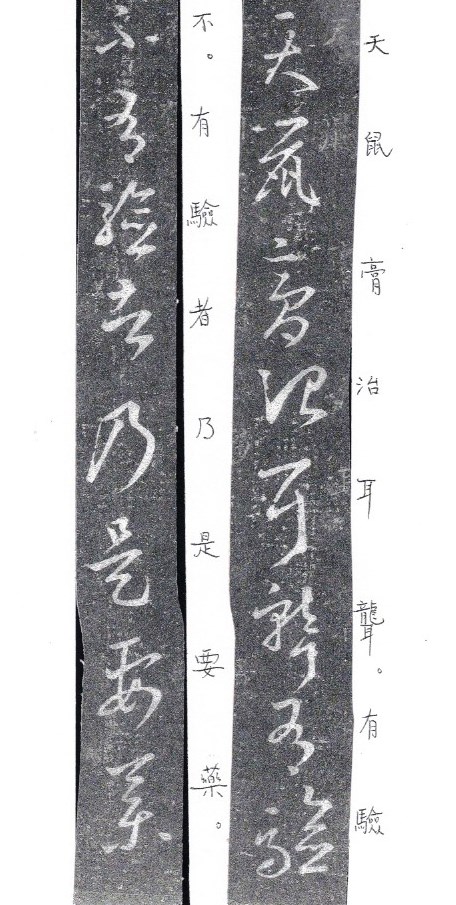
天鼠膏治耳聾,有驗不(否)?有驗者乃是要藥。
Tian Shu Gao (ointment) for curing deafness. Is it effective? If it works, it is indeed an important medicine.
10 Zhu Chu Ren Tie (朱處仁帖)
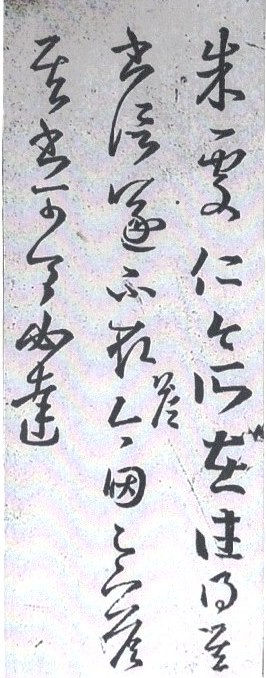

朱處仁今所在,往得其書,信遂不取答。今因足下答其書, 可令必達。
Where is Zhu Churen (朱處仁) currently at? I used to receive letters from him but recently he has not replied my letters. Since now you (Zhou Fu 周撫) are writing to him, you can relay my message to him.
To be continued……
Please click the following link for letters 11 to 20.
Cursive script: Shiqi Tie (The Seventeenth) of Wang Xizhi 王羲之十七帖 (Part 2)
Please click the following link for letters 21 to 29.
Cursive script: Shi Qi Tie (The Seventeenth) of Wang Xizhi 王羲之十七帖 (Part 3)
Bibliography
https://zh.wikipedia.org/wiki/%E9%83%97%E6%84%94 郗愔 (313-384), 字方回…)
https://zh.wikipedia.org/wiki/%E9%83%97%E6%9B%87 郗曇 (320-361), 字重熙…)
https://zh.wikipedia.org/zh-sg/%E5%91%A8%E6%92%AB 周撫 (?-365), 字道和…)
https://www.sohu.com/a/443385263_584699 (王羲之《十七帖》全集+释文!
https://baike.baidu.com/item/%E5%8D%81%E4%B8%83%E5%B8%96/9400210 (十七帖)
渡邊隆男 (1988) 東晉王羲之 十七帖二種 二玄社ISBN 4-544-00514-0
祁小春 (2010) 王羲之 十七帖 ·湖北美术出版社 ISBN 978-7-5394-3712-5
龙友 王玉池 (2011) 名碑各帖完全大观•王羲之十七帖 江西美术出版上社 ISBN 978-7-5480-0666-4
俞丰 (2009) 經典碑帖釋文譯注, 上海書畫出版社, ISBN 978-7-80725-846-9
蔣勳 (2010) 手帖 南朝嵗月, INK 印刻文學生活雜誌出版有限公司 ISBN 978-986-6377-94-5
Ouyang Z S, W C Fong, Y F Wang (2008) Chinese Calligraphy, Yale University, ISBN 978-0-300-12107-0
